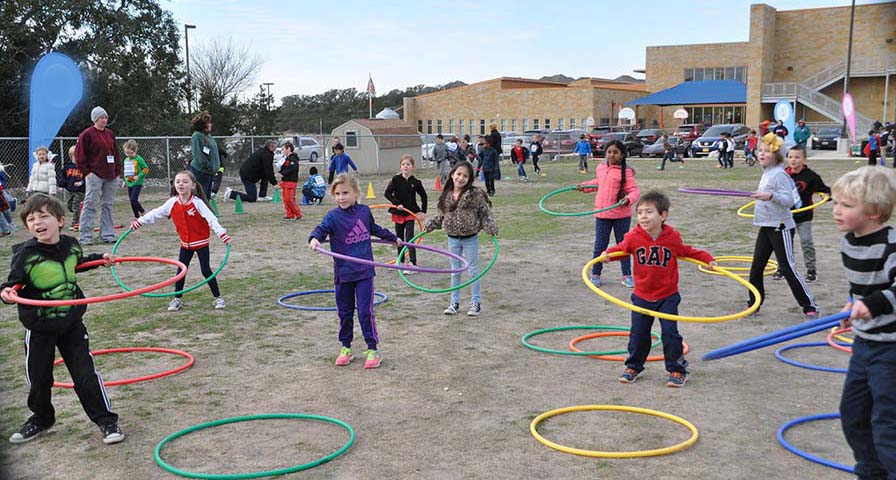Elementary Students Display Improved Performance, Increased Attention to Exercise Habits
By pairing funding from his local education foundation with technology department funding, Lincoln (St. Charles, Ill.) Elementary School PE teacher Will Navis added key fitness tools to his program.
Looking to purchase a class set of IHT ZONE wrist heart rate monitors along with the IHT Spirit System assessment software to enhance student motivation in class, Navis needed close to $5,000. He just didn’t know where he’d find it in one place.
Late in the 2017-18 school year, Navis searched several places, including his school’s technology department and the local St. Charles Education Foundation, a non-profit entity that raises money to be spent where the school district’s budget falls short.
“They do a couple of fundraisers throughout the year, and all of those funds are given out in grants,” Navis said. “I’ve won a couple of grants from them for other things, but this has been by far my biggest one.”
Navis applied for and received a grant for $2,500, nearly half of the cost and exactly what he needed to show his technology officer.
“I got half of my funding through this grant and the other half from a conversation I had with our technology officer about a year ago,” Navis, the current president of the Illinois Association for Health, Physical Education, Recreation and Dance, said.
While researching how he could order tablets to be used for his IAHPERD conferences through his school, he asked about available funding for technology he could use directly with his students. The technology budget didn’t have a lot of money available, but the officer made Navis a commitment.
“I told him that it was going to be about $5,000 and I didn’t have that in my budget but could he help me with any of it?” Navis recalled. “He told me that if I wrote the foundation grant and got half the funding, the technology department would match it. I thought that was awesome.”
Impacting Student Engagement with Technology
Navis received the heart rate monitors at the beginning of the current school year and began using them with his third, fourth and fifth-grade classes. As he began collecting data, he noticed student engagement skyrocketing, manifest by the amount of time each student is spending in their target heart rate zones.
“There are definitely kids who are highly motivated by them,” he said. “I’m seeing a change in what they are choosing to do [during class] so they keep their heart rate up higher.”
Not only does Navis see it as he scans the class during sessions, he sees it in the reports he can run following class through the Spirit System. In a recent presentation to the education foundation, Navis showed members exactly what their funding enables him to do.
“I did some screenshots of some of the reports,” he said. “They were just floored. ‘You get all that?’ ‘Yes, I get all of that, and I can email it to parents.’ They were very impressed.”
Stay in contact with funding sources
With a limited PE budget that can make it challenging to add tools that can help students improve both their fitness and their academic readiness, Navis works hard to identify funding sources and cultivate relationships with those groups. Some of his sources include:
- The St. Charles Education Foundation
- Lincoln Elementary School Parent-Teacher Organization (PTO)
- School district budget
- State AHPERD organizations
In addition to the St. Charles Education Foundation, Navis works closely with his PTO. Had he not received the foundation award, he was prepared to seek funding elsewhere.
“Their commitment to PE is amazing,” Navis said.
Navis said the PTO has supported a wellness fair for the last seven years. The first year, the PTO donated $100 to purchase smoothies for fair attendees, and their contribution has increased each year. On a typically frigid January day, Navis approached the PTO president about helping him purchase his ZONEs.
“I remember it was a very cold morning at bus duty,” he said. “The PTO president at the time, after she dropped off her kids, listened while I explained what I was thinking about the IHT technology. She said, ‘that’s a lot of money but let me talk and we’ll see what we might be able to do.’”
Before Navis learned he’d won funding from the education foundation, Navis said the PTO committed to giving $1,000 to the PE department if necessary. While he didn’t need it, he hopes other teachers learn from the opportunity.
“Obviously I didn’t need to use that, but it’s another example of what I was exploring,” he said. “My backup plan was to apply for a patchwork of other grants, most of which would be $500.”
Identify Multiple Funding Sources and Apply
Another potential funding source, Navis said, is the AHPERD in each state or region. While he’s ineligible to receive funding from IAHPERD because he’s an officer, he sees how his organization awards funding and says not enough teachers take advantage of these opportunities.
“At IAHPERD we have two grant cycles each year and I think we give out about $20,000 each time,” he said. “There have been a few seasons where we’ve hardly gotten any applications, so the people who did apply for grants got what they asked for. I’m sure other state associations have similar grant opportunities as well.”
The search for funding will always be a challenge for PE teachers. By identifying and working closely with funding sources, teachers can improve their chances at earning the funding they can use to positively impact their students.
Seeking IHT Spirit System information?


